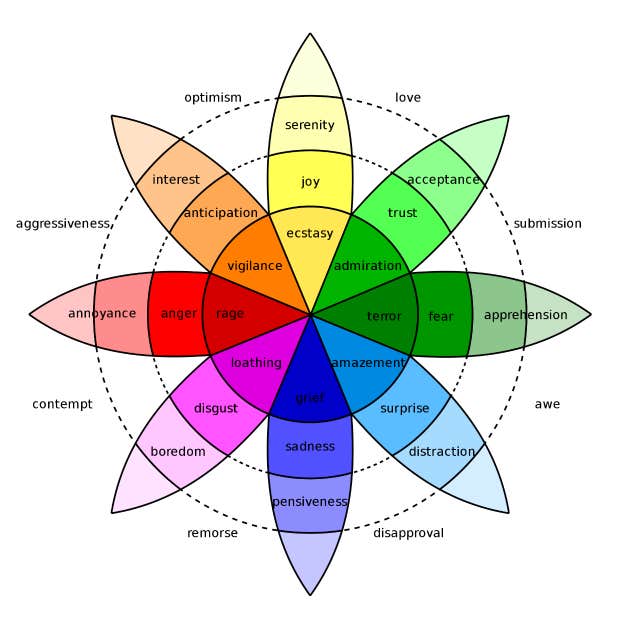The Different Types Of Basic Human Emotions, Explained
Understanding the basics of human emotions means deeper connections and happier relationships.
 Master1305 / shutterstock
Master1305 / shutterstock Understanding your emotions and being able to identify them in the present moment is an essential tool for creating happy relationships that thrive and stand the test of time.
In relationships, we all want to feel understood as much as we want to understand others. Knowing what we are feeling and being able to accurately communicate it while being present and compassionate toward what others are feeling helps to create a deep connection.
What are the different types of basic human emotions?
The answer depends on who you ask and which theory you believe makes the most sense.
As human beings sharing a world together, we are always seeking to better understand each other and how we can get along best. In the pursuit of the answers to such important questions, many researchers, sociologists, and psychologists have debated the idea of whether or not there is a list of universal human emotions and related facial expressions.
Though reading facial expressions is part of the puzzle, it actually misses the mark in creating understanding and authentic connection, leaving out key factors like body language and tone of voice, but more on that below.
In his article, "The Universally Recognized Facial Expressions of Emotion," Cole Calistra gives a general history of the research, noting that, in 1872, Charles Darwin wrote, “Facial expressions are universal, not learned differently in each culture.”
Since that time, three core theories of human emotion have dominated the conversation:
- Dr. Paul Ekman's list of 6 human emotions as categories
- Dr. Robert Plutchik's wheel of emotions (with 8 primary emotions at the core)
- Dethmer, Chapman, and Klemp's list of 5 basic emotions
Ekman's List of 6 Basic Human Emotions
In 1960, psychologist Paul Ekman identified this list of different core or primary human emotions he believed to be universal:
1. Enjoyment
The facial expression of enjoyment, or happiness, is characterized by raising the corners of the mouth in an obvious smile, accompanied by tightening of the eyelids.

2. Surprise
The facial expression of surprise is characterized by arched eyebrows, wide-open eyes with the white of the eye exposed, and the jaw dropping open slightly.

3. Sadness
The facial expression of sadness is characterized by lowered corners of the mouth, eyebrows lowering the inner corners of the eye, and drooping eyelids.

4. Anger
The facial expression of anger is characterized by furrowed eyebrows, firmly pressed lips, and bulging eyes.

5. Disgust
The facial expression of disgust is characterized by a raised upper lip, a wrinkled bridge of the nose, and raised cheeks.

6. Fear
The facial expression of fear is characterized by raised upper eyelids, eyes open wide, and lips stretched side-to-side.

Contempt is a seventh basic emotion
Contempt, characterized by half of a tightened upper lip and head tilted slightly back, is sometimes considered to be the seventh universal human emotion, with Ekman adding it to his list of emotions in the 1990s.
 All photos: Getty
All photos: Getty
Plutchik's Wheel of Emotions
In 1980, psychologist Robert Plutchik expanded on Ekman's concept, creating what he called the wheel of emotions.
Based on the concept of a color wheel, Plutchik believed there were 8 primary emotions (like primary color), which could be blended, diluted, or intensified to create different shades and nuances.
 Photo: Wikipedia/Public Domain
Photo: Wikipedia/Public Domain
8 Basic Emotions in Plutchik's Emotion Wheel
1. Joy
Opposite emotion: Sadness
2. Anger
Opposite emotion: Fear
3. Trust
Opposite emotion: Disgust
4. Surprise
Opposite emotion: Anticipation
5. Sadness
Opposite emotion: Joy
6. Fear
Opposite emotion: Anger
7. Disgust
Opposite emotion: Trust
8. Anticipation
Opposite emotion: Surprise
Both of these theories hold that certain facial expressions are universally interpreted as indicating specific emotions.
22 Secondary Human Emotions on Plutchik's Wheel
- Ecstasy
- Admiration
- Terror
- Amazement
- Grief
- Loathing
- Rage Vigilance
- Serenity
- Acceptance
- Apprehension
- Distraction
- Pensiveness
- Boredom
- Annoyance
- Interest
- Love
- Submission
- Awe
- Disapproval
- Remorse
- Contempt
- Aggressiveness
Are these basic human emotions truly universal?
Back to Calistra, he also notes the work of the Interdisciplinary Affective Science Laboratory, which found there may have been some bias in previous experiments and that these lists of emotions may not be truly universal.
In 2014, a team of researchers from Northeastern University, the University of Essex, and the University of Namibia conducted a study in which participants from the United States and the Himba ethnic group from the Kunene region of northwestern Namibia were asked to sort images of posed facial expressions into piles by emotion type.
In contrast to the Americans involved, members of the Namibian tribe were only able to categorize expressions as falling into the categories of either “laughing” or “looking.” Their language and culture impacted the way they interpreted what they saw on the faces of others.
It seems that both camps’ positions are partially true.
Facial expressions can convey positive and negative emotions, but the context from which an observer is perceiving those expressions impacts the meaning they find in another person’s facial expression.
It's important to note that none of these theories take into consideration the important factors of body language or tone of voice, both of which are critical to recognizing emotions in others.
As we all know, someone can appear to be happy and complying — smiling and nodding yes, for example — while their body language, like crossed arms, may convey a totally different message of resistance and anger.
How can we use emotions as a guide to connection in relationships?
It's an important question, especially because the experts cannot agree on a universal list of basic emotions and people send mixed messages through body language.
Lucky for us, we don’t actually need to know what others are thinking and feeling by reading them. There is a much quicker, more direct route to creating connection and understanding — and it starts with each of us as individuals.
Instead of focusing our attention outside ourselves and interpreting what is happening out there, we can turn our attention inward and experience what is happening inside ourselves.
In order to authentically and truthfully connect with another human being, we need to be clear about what we are feeling so we can accurately communicate our experience.
Which leads us to the third model of human emotions.
Dethmer, Chapman, and Klemp's List of 5 Basic Emotions
For some, it's easiest to work with the model proposed by Jim Dethmer, Diane Chapman, and Kaley Klemp in their book "The 15 Commitments of Conscious Leadership: A New Paradigm for Sustainable Success."
They identify the following list of five basic emotions:
- Anger
- Sadness
- Joy
- Fear
- Sexual (or creative) feelings
All other feelings we experience are either nuanced versions of one of these basic emotions (like rage, which is intense anger) or a combination of two or more of those basic emotions (like frustration, which is a combination of fear and anger).
They go on to describe emotion in the following way: “Emotion is 'e-motion.' Energy in motion. At its simplest level, emotion is energy moving in and on the body." Or said another way, "feelings are physical sensations.” This is good news!
If emotions are physical sensations, that means two things:
- Emotions are merely a natural and automatic physical reaction to our thoughts.
- Being natural and automatic, they are neither good nor bad, just something our bodies do to tell us what we are thinking.
This makes our job of knowing what is going on inside ourselves a whole lot easier when the information is right there, literally at our fingertips, and we let go of judgment and just observe.
The first step is paying attention to physical sensations. The second step is communicating what we feel to others.
For instance, in an argument with another person, instead of saying, “You’re so mean” and exchanging insults, turn your attention inward to the physical sensations you find present. From that awareness, it would be more accurate to say, “I feel an intense ache in my chest and I also feel nauseous. I feel sad and scared.”
That kind of statement clearly conveys what you are experiencing and at the same time does not inherently invite defensiveness or challenge. It invites the other into your experience. It invites understanding and connection.
Whether the other person is willing to do the same is not guaranteed, but it is certainly more likely to happen when someone is invited into an experience rather than being criticized.
Regardless, staying in touch with your emotions allows you to create deeper connections to your own experiences, and certainly leads to more understanding between individuals.
What better way can there be to make ourselves known to others than to know ourselves first; and, what better way to connect with others than to show up from a state of compassion and understanding?
From that state of mind, those expressions you see on other people's faces may look less like a puzzle to solve and more like an invitation to connect and understand one another on a whole new level.
Michelle Thompson is a life coach specializing in personal and relationship transformation, helping stuck individuals and couples improve their positive energy flow, reconnect with their inner selves and their partners, and embrace their capacity to love more fully.
